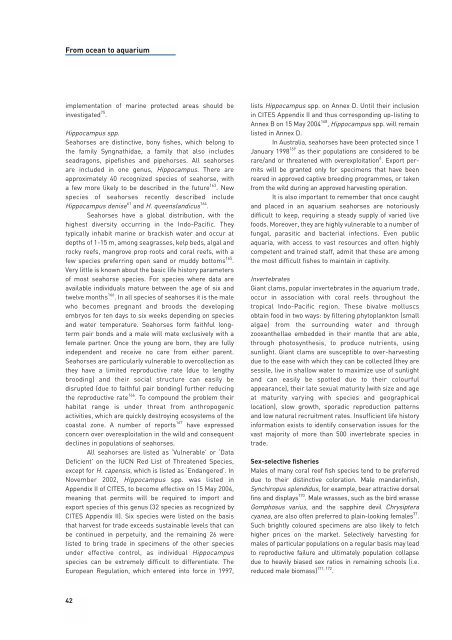The global trade in marine ornamental species
The global trade in marine ornamental species
The global trade in marine ornamental species
You also want an ePaper? Increase the reach of your titles
YUMPU automatically turns print PDFs into web optimized ePapers that Google loves.
From ocean to aquarium<br />
implementation of mar<strong>in</strong>e protected areas should be<br />
<strong>in</strong>vestigated 75 .<br />
Hippocampus spp.<br />
Seahorses are dist<strong>in</strong>ctive, bony fishes, which belong to<br />
the family Syngnathidae, a family that also <strong>in</strong>cludes<br />
seadragons, pipefishes and pipehorses. All seahorses<br />
are <strong>in</strong>cluded <strong>in</strong> one genus, Hippocampus. <strong>The</strong>re are<br />
approximately 40 recognized <strong>species</strong> of seahorse, with<br />
a few more likely to be described <strong>in</strong> the future 163 . New<br />
<strong>species</strong> of seahorses recently described <strong>in</strong>clude<br />
Hippocampus denise 61 and H. queenslandicus 164 .<br />
Seahorses have a <strong>global</strong> distribution, with the<br />
highest diversity occurr<strong>in</strong>g <strong>in</strong> the Indo-Pacific. <strong>The</strong>y<br />
typically <strong>in</strong>habit mar<strong>in</strong>e or brackish water and occur at<br />
depths of 1-15 m, among seagrasses, kelp beds, algal and<br />
rocky reefs, mangrove prop roots and coral reefs, with a<br />
few <strong>species</strong> preferr<strong>in</strong>g open sand or muddy bottoms 165 .<br />
Very little is known about the basic life history parameters<br />
of most seahorse <strong>species</strong>. For <strong>species</strong> where data are<br />
available <strong>in</strong>dividuals mature between the age of six and<br />
twelve months 166 . In all <strong>species</strong> of seahorses it is the male<br />
who becomes pregnant and broods the develop<strong>in</strong>g<br />
embryos for ten days to six weeks depend<strong>in</strong>g on <strong>species</strong><br />
and water temperature. Seahorses form faithful longterm<br />
pair bonds and a male will mate exclusively with a<br />
female partner. Once the young are born, they are fully<br />
<strong>in</strong>dependent and receive no care from either parent.<br />
Seahorses are particularly vulnerable to overcollection as<br />
they have a limited reproductive rate (due to lengthy<br />
brood<strong>in</strong>g) and their social structure can easily be<br />
disrupted (due to faithful pair bond<strong>in</strong>g) further reduc<strong>in</strong>g<br />
the reproductive rate 166 . To compound the problem their<br />
habitat range is under threat from anthropogenic<br />
activities, which are quickly destroy<strong>in</strong>g ecosystems of the<br />
coastal zone. A number of reports 167 have expressed<br />
concern over overexploitation <strong>in</strong> the wild and consequent<br />
decl<strong>in</strong>es <strong>in</strong> populations of seahorses.<br />
All seahorses are listed as ‘Vulnerable’ or ‘Data<br />
Deficient’ on the IUCN Red List of Threatened Species,<br />
except for H. capensis, which is listed as ‘Endangered’. In<br />
November 2002, Hippocampus spp. was listed <strong>in</strong><br />
Appendix II of CITES, to become effective on 15 May 2004,<br />
mean<strong>in</strong>g that permits will be required to import and<br />
export <strong>species</strong> of this genus (32 <strong>species</strong> as recognized by<br />
CITES Appendix II). Six <strong>species</strong> were listed on the basis<br />
that harvest for <strong>trade</strong> exceeds susta<strong>in</strong>able levels that can<br />
be cont<strong>in</strong>ued <strong>in</strong> perpetuity, and the rema<strong>in</strong><strong>in</strong>g 26 were<br />
listed to br<strong>in</strong>g <strong>trade</strong> <strong>in</strong> specimens of the other <strong>species</strong><br />
under effective control, as <strong>in</strong>dividual Hippocampus<br />
<strong>species</strong> can be extremely difficult to differentiate. <strong>The</strong><br />
European Regulation, which entered <strong>in</strong>to force <strong>in</strong> 1997,<br />
lists Hippocampus spp. on Annex D. Until their <strong>in</strong>clusion<br />
<strong>in</strong> CITES Appendix II and thus correspond<strong>in</strong>g up-list<strong>in</strong>g to<br />
Annex B on 15 May 2004 168 , Hippocampus spp. will rema<strong>in</strong><br />
listed <strong>in</strong> Annex D.<br />
In Australia, seahorses have been protected s<strong>in</strong>ce 1<br />
January 1998 169 as their populations are considered to be<br />
rare/and or threatened with overexploitation 6 . Export permits<br />
will be granted only for specimens that have been<br />
reared <strong>in</strong> approved captive breed<strong>in</strong>g programmes, or taken<br />
from the wild dur<strong>in</strong>g an approved harvest<strong>in</strong>g operation.<br />
It is also important to remember that once caught<br />
and placed <strong>in</strong> an aquarium seahorses are notoriously<br />
difficult to keep, requir<strong>in</strong>g a steady supply of varied live<br />
foods. Moreover, they are highly vulnerable to a number of<br />
fungal, parasitic and bacterial <strong>in</strong>fections. Even public<br />
aquaria, with access to vast resources and often highly<br />
competent and tra<strong>in</strong>ed staff, admit that these are among<br />
the most difficult fishes to ma<strong>in</strong>ta<strong>in</strong> <strong>in</strong> captivity.<br />
Invertebrates<br />
Giant clams, popular <strong>in</strong>vertebrates <strong>in</strong> the aquarium <strong>trade</strong>,<br />
occur <strong>in</strong> association with coral reefs throughout the<br />
tropical Indo-Pacific region. <strong>The</strong>se bivalve molluscs<br />
obta<strong>in</strong> food <strong>in</strong> two ways: by filter<strong>in</strong>g phytoplankton (small<br />
algae) from the surround<strong>in</strong>g water and through<br />
zooxanthellae embedded <strong>in</strong> their mantle that are able,<br />
through photosynthesis, to produce nutrients, us<strong>in</strong>g<br />
sunlight. Giant clams are susceptible to over-harvest<strong>in</strong>g<br />
due to the ease with which they can be collected (they are<br />
sessile, live <strong>in</strong> shallow water to maximize use of sunlight<br />
and can easily be spotted due to their colourful<br />
appearance), their late sexual maturity (with size and age<br />
at maturity vary<strong>in</strong>g with <strong>species</strong> and geographical<br />
location), slow growth, sporadic reproduction patterns<br />
and low natural recruitment rates. Insufficient life history<br />
<strong>in</strong>formation exists to identify conservation issues for the<br />
vast majority of more than 500 <strong>in</strong>vertebrate <strong>species</strong> <strong>in</strong><br />
<strong>trade</strong>.<br />
Sex-selective fisheries<br />
Males of many coral reef fish <strong>species</strong> tend to be preferred<br />
due to their dist<strong>in</strong>ctive coloration. Male mandar<strong>in</strong>fish,<br />
Synchiropus splendidus, for example, bear attractive dorsal<br />
f<strong>in</strong>s and displays 170 . Male wrasses, such as the bird wrasse<br />
Gomphosus varius, and the sapphire devil Chrysiptera<br />
cyanea, are also often preferred to pla<strong>in</strong>-look<strong>in</strong>g females 37 .<br />
Such brightly coloured specimens are also likely to fetch<br />
higher prices on the market. Selectively harvest<strong>in</strong>g for<br />
males of particular populations on a regular basis may lead<br />
to reproductive failure and ultimately population collapse<br />
due to heavily biased sex ratios <strong>in</strong> rema<strong>in</strong><strong>in</strong>g schools (i.e.<br />
reduced male biomass) 171, 172 .<br />
42
















